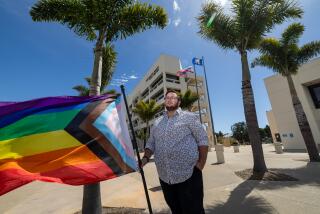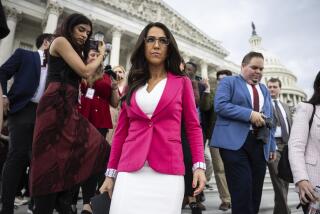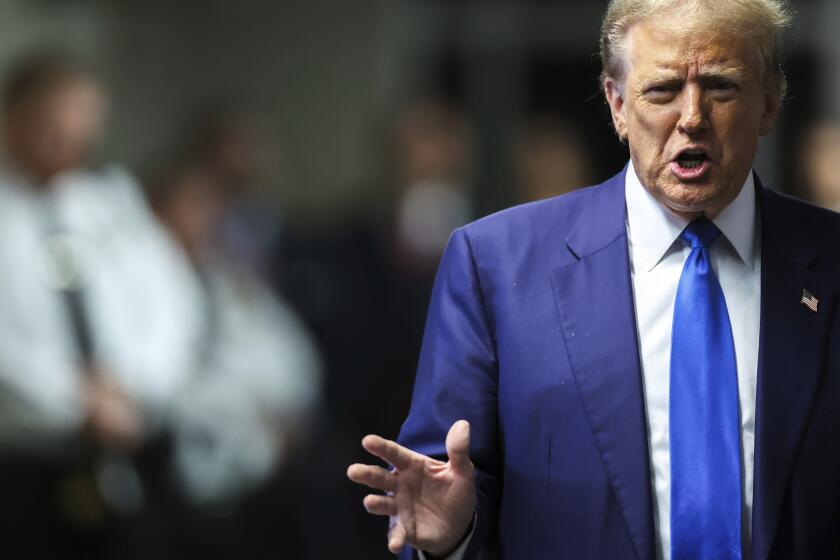Medi-Cal plan has doctors divided
With an outraged tone, Dr. Samuel Fink dismisses Gov. Arnold Schwarzenegger’s proposal to tap physicians to help pay for universal healthcare.
“That makes about as much sense as taxing teachers to provide a better education, or taxing Assembly members or senators to pay for upkeep of the Capitol,” said Fink, a Tarzana internist. “We’re part of the solution, not the problem.”
But Hector Flores, a family physician who practices in East Los Angeles, is in a minority that supports the governor’s idea of collecting 2% of physicians’ gross income to help pay for a $4-billion increase in Medi-Cal payments that the state makes to doctors who tend to the poor.
“Most of the physicians who complain about this aren’t really serving the Medi-Cal or low-income population anyway,” said Flores, whose 22-doctor office treats a large number of uninsured and poor patients. “These are the docs who don’t mind paying $10,000 to join an exclusive club somewhere.”
Represented by one of the Capitol’s dominant lobbies, California’s physicians are respected for their successful ability to forge a united front against incursions into their field. But this year, when healthcare is the central issue before the Legislature, the profession is practicing the political equivalent of defensive medicine, grappling with their increasingly divided membership as they try to ward off proposals that would hurt them economically.
Along with trying to block Schwarzenegger’s proposed assessment, the California Medical Assn. is working to persuade Democratic lawmakers to increase Medi-Cal fees without placing a levy on doctors’ incomes. The CMA, which represents about half of the state’s physicians, also opposes a proposal to create a single government-run insurer out of concerns it would lead to low reimbursement rates like those from Medi-Cal.
All these efforts, critics charge, expose tensions that physicians prefer to downplay between their roles as patient advocates and as members of a lucrative profession.
“While lots of doctors would like to see everybody covered, when it gets down to who’s going to pay, they seem no more eager than anyone else in this conversation,” said Dr. Mark Smith, president of the California Health Care Foundation, an Oakland nonprofit philanthropy.
This year’s debate over healthcare has exposed a number of other fissures: between doctors with profitable practices and those who tend to the poor; between those who are paid for services and those who work in managed care; and between those reluctant to tamper with the current system and those who want to discard it.
Though the governor’s fee is strongly opposed by the CMA, the California Assn. of Physician Groups, another lobbying group that represents 150 managed-care entities that employ or contract doctors, has taken no position on the issue. Don Crane, the group’s president, said the group “applauds and believes in the concept of shared responsibility.” The phrase “shared responsibility” is Schwarzenegger’s favored slogan for requiring everyone, including doctors, to make financial concessions in the name of universal care.
The rates Medi-Cal pays doctors to treat the poor are lower than in all but six other states and the District of Columbia, according to the Kaiser Family Foundation. The CMA dismissively noted in a report last year that Medi-Cal pays doctors $24 for an office visit, the cost of a large pizza. Over the last 12 months, 40% of California’s doctors did not participate at all in the Medi-Cal program, making it especially hard for the poor to obtain medical care.
“The rates are so low that a lot of doctors just can’t afford to see these patients,” said Dr. Paul Urrea, a pediatric ophthalmologist from Monterey Park. Urrea, who practices at White Memorial Medical Center in Montebello, favors the governor’s proposal.
But some California doctors say that even though they don’t work much with Medi-Cal, they still provide substantial care for the poor. Dr. Richard Corlin, a Santa Monica gastroenterologist and former CMA president, said his practice provided $250,000 worth of free care to the Venice Family Clinic last year.
“Physicians and hospitals and, increasingly, pharmaceutical companies carry their share of the burden,” he said. “Health plans don’t. They don’t provide a penny for medical education benefits, and they really don’t provide uncompensated care to the poor.”
There are 99,150 licensed physicians and osteopaths in California, according to state licensing boards. Nationally, the profession remains financially rewarding: In 2004, the median income for a family care doctor was $156,000, while the median income for a heart surgeon -- the wealthiest specialty -- stood at $428,000, according to the Medical Group Management Assn., a Colorado group.
Doctors say Schwarzenegger’s 2% assessment is excessive because it would not be placed on a doctor’s net income but on all office revenue. Many doctors say it would amount to at least 4% of their take-home pay.
In a sign of doctors’ strong reputation among the public, a March poll by the Public Policy Institute of California found that the levy on medical providers was the least popular aspect of Schwarzenegger’s proposal. The poll found that only 41% of Californians said doctors and hospitals should be forced to make financial contributions to expand healthcare. Meanwhile, 75% of those surveyed favored another provision in Schwarzenegger’s plan, requiring everyone to carry insurance and businesses to provide coverage or pay into a state fund.
The CMA is trying to play a positive role in the debate. It helped found a coalition of insurers, unions and hospitals that hopes to rally public pressure in favor of healthcare reform. But the interests of members of the group, Together for Health Care, are so divergent that so far the alliance has not been able to settle on endorsing any specific proposal.
For example, an initial political campaign put together by the group’s consultant, Democratic veteran David Doak, implicitly blamed insurers for the healthcare crisis. Not surprisingly, the approach was rejected after coalition members from the insurance industry, including Health Net, Kaiser Permanente and Blue Shield of California, objected. The group is working on a more acceptable set of commercials.
Dr. Anmol Mahal, the CMA’s president, said that though the 2% assessment has been a “significant distraction,” the physicians are focused on forging a plan that works for everyone.
“None of the plans in themselves are a complete solution,” he said. “We feel we have to work on these plans through negotiations with the governor and through this coalition to come up with a plan that is acceptable.”
To amplify its influence, the CMA has hired as its chief executive Joe Dunn, a former state senator from Orange County who previously was a member of the trial bar, one of the doctors’ traditional political nemeses. Dunn pledges to increase the aggressiveness of a profession that complains it has been beaten down by perpetual battles with insurers over cases.
“We will be very aggressive, far more aggressive than we ever have been, if the healthcare discussions start to go in a direction that will further erode the relationship between the physicians and their patients,” Dunn said.
The defensive posture the doctors have been forced to adopt this year is a far cry from their role in the state’s last healthcare debate, in 2003. Then, the CMA wrote and helped pass a law requiring large employers to provide healthcare insurance. The law was narrowly repealed by voters the following year.
“Their ambivalence is robbing them of some power in the Capitol,” said Sen. Sheila Kuehl (D-Santa Monica), chairwoman of the Senate Health Committee and the sponsor of the state-run insurer legislation. “You have to be very clear when you’re advocating for something. Everyone expected they would advocate against being taxed, but it’s not clear what they’re for.”
More to Read
Get the L.A. Times Politics newsletter
Deeply reported insights into legislation, politics and policy from Sacramento, Washington and beyond. In your inbox three times per week.
You may occasionally receive promotional content from the Los Angeles Times.






